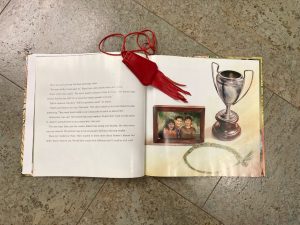10 The Gathering Tree
Danielle Davis
Contributor’s Biography:
Danielle Davis is working towards a Bachelors of Arts majoring in History at Kwantlen Polytechnic University.
Resource Overview
Book/ Audiobook:
Loyie, L. (2006). The Gathering Tree. Theytus Books.
Grade Level: Grades Three – Seven
Description:
“The Gathering Tree” discusses how one family and their community cope with learning how to understand HIV. The book showcases some of the community’s spiritual traditions, such as the running journey to the Gathering Tree and its corresponding healing powers. The book elaborates on the works and reasons for gatherings. They are intended to share knowledge, in this case, understanding of a disease that many did not understand. During his journey to self-awareness, one of the main characters learns the traditional fishing methods and is honoured when he catches his first fish. A family shows prejudice towards people living with HIV, and another character has to learn coping strategies. Near the end, the story implies that prejudice was overcome through knowledge sharing and empowerment of the community. It showcases a sense of community and discusses how everyone at the gathering works together to make it a successful and joyous occasion.
Significant Indigenous Knowledge:
Indigenous communities are seeing more and more cases of HIV in both men and women. Although there have been strides in researching how to treat HIV, the most effective solution is taking preventative measures. Knowledge sharing within Indigenous communities helps to decrease the number of cases. By sharing HIV information in Indigenous communities, Indigenous children learn how to stay safe and healthy. The book highlights the significance that Elders play in Indigenous communities and how they can help influence and educate children on HIV through traditional gatherings.
Necessary Prior Knowledge:
Before using this resource, it is recommended that the educator reviews the content before presenting the lesson as it includes lots of detail. In the back of the book, there are commonly asked questions and answers regarding HIV. The book also highlights the importance of learning traditions that have been passed on through generations. Examples of common traditions celebrated worldwide would help reinforce the concept and give participants context. Also, another theme the book features are learning how to cope with prejudice. Again, historical context would help solidify the lesson and theme. Lastly, Indigenous Peoples in this resource believe there is great strength in knowledge, and sharing this wisdom is essential in assisting participants in understanding its messages.
Suggested Learning Activities
One of the possible activities would start by reading the book to the participants and having an open discussion. These discussions can give the facilitator and participants a different perspective. The following day would focus on traditions, such as the traditional fishing in the book. Participants would then be invited to share and learn one another’s cultural and familial traditions, helping them understand the plethora of traditional norms in various societal settings. Such discussions help broaden their perspectives and allow them to speak about their likes and dislikes, thus eliciting engagement. Lastly, the facilitator would guide the conversation into one which focuses on moments in which the participants have been taught how to do something and felt proud of their accomplishment. The lesson could end with the discussion or follow up with a journal entry that includes a drawing highlighting their learned skills and talents.
A second activity would be to teach participants about prejudice. The focus would be on how prejudice can often be caused by a lack of understanding and knowledge. Participants would be invited to voluntarily share examples of things that others may not understand about them. Perhaps they could also share something that may not be understood about one of their friends, allowing them to discuss challenges while remaining anonymous. Children would gain situational and circumstantial awareness of the members of their classroom community, allowing participants to understand each other better. It may even help connect participants who think they are different but unknowingly have a similar classmate. The discussion would also highlight a sense of community and its importance, helping participants feel supported.

The Gathering Tree
Image by: Rachel Chong BY-NC-ND (Attribution Non-Commercial No Derivatives)
References
Loyie, L. (2006). The Gathering Tree. Theytus Books.

